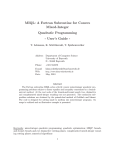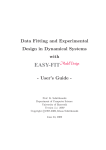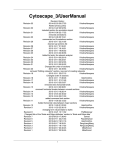Download MIQL: A Fortran Subroutine for Convex Mixed
Transcript
MIQL: A Fortran Subroutine for Convex Mixed-Integer Quadratic Programming - User’s Guide T. Lehmann, K. Schittkowski Address: Prof. K. Schittkowski Siedlerstr. 3 D - 95488 Eckersdorf Germany Phone: (+49) 921 32887 E-mail: [email protected] Web: http://www.klaus-schittkowski.de Date: October, 2013 Abstract The Fortran subroutine MIQL solves strictly convex mixed-integer quadratic programming problems subject to linear equality and inequality constraints by a branchand-bound method. The continuous subproblem solutions are obtained by the primaldual method of Goldfarb and Idnani. The code is designed for solving small to medium size mixed-integer programs. Its usage is outlined and an illustrative example is presented. Keywords: mixed-integer quadratic programming; quadratic optimization; MIQP; branchand-bound; numerical algorithms 1 1 Introduction The Fortran subroutine MIQL solves strictly convex-mixed integer quadratic programming problems subject to linear equality and inequality constraints of the form T T x x 1 T +d min 2 x , y C y y x j = 1, . . . , me , aTj + bj = 0 , y x ∈ Rn c , y ∈ Nn i : (1) x T aj j = me + 1, . . . , m , + bj ≥ 0 , y xl ≤ x ≤ xu , yl ≤ y ≤ yu , with an n by n positive definite matrix C and n := ni + nc , an n-dimensional vector d, an m by n matrix A = (a1 , ..., am )T , and an m-vector b. Lower and upper bounds for the continuous and integer variables, xl , xu , yl and yu respectively, are separately handled. The objective function of (1) is denoted by 1 T T x x T f (x, y) = (x , y )C +d . (2) y y 2 If ni > 0, the mixed-integer quadratic program (1) is now solved by a branch-and-bound method. This manual is organized as follows. The subsequent section introduces the basic concept of a branch-and-bound method and describes the different options of the underlying Fortran subroutine. Section 3 describes more details of the implementation, especially the warm start features. Section 4 summarizes some numerical results to compare different options. Further implementation details and program documentation are found in Section 5, followed by an illustrative example in Section 6. 2 The Branch-and-Bound Procedure A branch-and-bound algorithm starts at the solution of the relaxed problem, in our case the optimal solution of a continuous quadratic program where the integrality condition y ∈ Nni is replaced by y ∈ Rni , see also Dakin [3] for an early paper on mixed-integer linear programming. An integer variable yk ∈ I is selected and two different continuous subproblems are generated. They are obtained by rounding the continuous value of yk , k ∈ I, to get two separate subproblems, one with upper bound yk , another one with lower bound yk + 1. 2 Each subproblem determines a node in a binary search tree, which is internally created step by step. A particular advantage of branch-and-bound methods is that certain subtrees can be eliminated or fathomed at an early stage before trying all possible combinations by exploring the whole tree. There are three: • A subproblem is infeasible: All subsequently generated subproblems obtained by branching from this node would also be infeasible. • A subproblem has a feasible integer solution. If the corresponding optimal objective function value is less than a known upper bound, a better upper bound is provided. A better solution cannot be generated starting from this node. • Let the optimal value of a non-integral solution of a subproblem be greater than the actual upper bound. Then further branching from the node would only increase function values, and there is no chance to find a better integer solution. A branch-and-bound method represents a general framework, which is easily adapted to other classes of mathematical optimization problems, say linear or nonlinear programming, see for example Gupta and Ravindran [6]. An essential assumption is the convexity of the given nonlinear program or the possibility to compute global solutions at all nodes. The integral node with minimal objective value represents the solution or we get the information that no feasible mixed-integer solution exists. Note that although the relaxed version of (1) is assumed to be a strictly convex optimization problem, the solution of the mixed-integer problem may not be unique. There is also a possibility to exploit lower bounds within a branch-and-bound algorithm by investigation the dual of (1), see Leyffer and Fletcher [9] for details. Thus, there remain decisions by which the numerical performance of a branch-and-bound algorithm may become influenced: 1. Select an integer variable with a non-integer value in the actual continuous solution of a node for branching: (a) maximal fractional branching: Select an integer variable from solution values of a relaxed subproblem with largest distance from neighbored integer values. (b) minimal fractional branching: Select an integer variable from solution values of a relaxed subproblem with smallest distance from neighbored integer values. 2. Search for a free node in the whole tree from where branching, i.e., the generation of two new subproblems, is initiated: (a) best of all: All free nodes are compared and a node with lowest objective function value is selected. 3 (b) best of two: The optimal objective function values of the two child nodes are compared and the node with a lower value is chosen. If both are leafs, i.e., if the corresponding solution is integral, or if the corresponding problem is infeasible or if there is already a better integral solution, strategy best of all is started. (c) depth first: Select a child node whenever possible. If the node is a leaf, the best of all strategy is applied. The depth first strategy has the advantage that the quadratic problem of a child node can be solved very fast, since the only difference between the both continuous programs is one additional box constraint. Usually, the search tree is smaller, i.e., there remain less unexplored nodes. The disadvantage is that the child node is arbitrarily selected leading to a possibly larger number of subproblems to be solved. After selecting an integer variable for branching and an unexplored node to continue, the optimal solutions of the corresponding relaxed quadratic programs are computed. This process is iterated until all nodes are either explored or fathomed. The upper bound is infinity until the first integer feasible solution is found. 3 Algorithmic Features of MIQL An essential component of a branch-and-bound is the ability to solve continuous quadratic programming problems very efficiently. The primal dual method of Goldfarb and Idnani [5] is frequently used to solve convex quadratic programs. To exploit as much information as possible from an existing solution within a branch-and-bound framework, we extend the Fortran code QL of Schittkowski [13]. This version is called QLX and its calling sequence is described in the next section. When called from MIQL, QLX performs warm starts depending on the relationship between successive subproblems, e.g., in a branch-and-bound procedure: 1. A new node is a child of the actual one, i.e., the new quadratic program is identical to the previous one apart from one additional box constraint subject to an integer variable. Since the primal-dual method of Goldfarb and Idnani successively adds constraints to the active set, we need, in most cases, only one additional iteration to get a new optimal solution. Even if more iterations are needed, almost always we save some calculation time compared to a complete new solution of the quadratic program. 2. The new node has the same parent node as the actual one, i.e., both problems differ only in one box constraint for an integer variable. The algorithm identifies the solution of a quadratic program by an linearly independent active set. A problem is solved by adding constraints to and eliminating constraints from the active set, until all constraints are satisfied, and each iterate is dual feasible. To enable a warm start in the present situation, one tries first to ensure dual feasibility. This is achieved by saving the active 4 constraints of the common parent node. They are compared to those of the child, i.e., the previously solved quadratic program. All other active constraints are eliminated. Then a dual feasible point is obtained and a new iteration of the algorithm is started by searching for a violated constraint. Time savings are achieved since in most cases, only few active constraints have to be deleted and added afterwards. 3. The new node is the child of a node which has the same parent node as the actual one (nephew): The warm start procedure is similar to the previous one. The only difference is that active constraints in the two child nodes are compared. This option is particularly efficient in case of the best of two strategy. It is possible that warm starts lead to numerical instabilities based on round-off errors. To avoid this situation, it is possible to limit the number of successive warm starts. In case of a numerical error, the problem is automatically resolved. Warm starts are indicated by parameter START of QLX that can obtain the following values: START 0 10 11 30 31 40 41 42 43 Warm start performed by QLX Normal execution, no warm starts performed. Dual warm start, where only bounds are changed. Dual warm start, where additional constraints are included. Warm start and early termination, only one QL iteration to be performed. Warm start and early termination, more than one QL iteration to be performed as provided by the parameter STEPS. Remove active constraints from the active set, where the number of these constraints is stored in the calling parameter NRDC and the indices of the constraints to be removed are specified in the array DELC. Remove active constraints from the active set analogue to START = 40, but continue afterwards with START = 30. Remove active constraints from the active set analogue to START = 40, but continue afterwards with START = 31. Remove active constraints from the active set analogue to START = 40, but continue afterwards with START = 10. Table 1: Warm Start Modes The term dual warm start indicates a situation where a known solution is dual feasible for the subsequent continuous program. START = 10 is applicable to a child problem during a branching step. Furthermore code QLX is able to handle the following special formulation of a quadratic 5 program in an efficiently. Suppose we want to solve a problem of the form x x 1 T T ˆ T min (x , z )C +d 2 z z np T T aj x + a ˆj z + bj = 0, j = 1, . . . , me , x∈R , ˆTj z + bj ≥ 0, z ∈ Rn−np : aTj x + a j = me + 1, . . . , m , (3) xl ≤ x ≤ xu , zl ≤ z ≤ zu where Cˆ is an n × n block-diagonal matrix C 0 , Cˆ = 0 CD (4) where C is a np × np matrix and CD is a (n − np ) × (n − np ) diagonal matrix. np ≤ n can be considered as reduced problem dimension. a ˆj is the j-th column of a matrix AD , i.e. the constraint matrix Aˆ is decomposed in the form A AD , (5) Aˆ = where A is a m × np matrix and AD is an m × (n − np ) diagonal matrix. This problem formulation (3) arises, e.g., when a quadratic program is relaxed by the introduction of m additional slack variables to ensure feasibility, or in special data mining problems related to support vector machines, see Schittkowski [14]. There are further features of our new version of our branch-and-bound code MIQL: 1. The new depth first search benefits from warm starts. 2. Since a node marked by a fathoming rule, is not needed any longer, the node data will become overwritten. 3. In case of false termination when solving a quadratic program, the whole process is not terminated and the error is treated in the same way as an infeasible leaf. 4. Improved bounds according to Leyffer and Fletcher [9] are calculated, if nodes are selected by best of all, by using warm start options START = 30 and START = 41 of QLX. 5. The branching direction for depth first search is determined by evaluating the Layj , where j is the selected branching variable and grangian function at ˆ yj and ˆ (ˆ x, yˆ) the solution of the previous branch-and-bound QP. 6 6. Lagrangian multipliers are be calculated independently of the solution method by a modified least squares approach, which uses an extended QP formulation to guarantee feasibility. This calculation is executed, if storage for (2n + m + 4)2 branch-and-bound nodes is provided. Otherwise, multipliers would depend, e.g., on the node selection strategy and the branching rule. Independent multipliers are especially useful, if MIQL is used as subproblem solver for the mixed-integer nonlinear solver MISQP of Exler and Schittkowski [4], since then Lagrangian multipliers are needed to calculate a BFGS update. 4 4.1 Numerical Results MISQP Subproblems All numerical results are obtained on a Intel E6600 Dual Core CPU with 2.4 GHz under Windows XP 64 using Intel Fortran Compiler version 9.1. For testing the nonlinear mixed-integer code MISQP, a large number of test problems have been implemented by Exler and Schittkowski [4]. Since in each iteration of the SQPbased method, a mixed-integer quadratic programming problem must be solved by MIQL, a large number of test examples is available. A subset of 35 MIQP subproblems is selected with calculation times over 0.1 seconds. Table 2 shows some characteristic data of the corresponding nonlinear programs. problem MITP57 MITP60 MITP62 MITP63 MITP66 MITP83 MITP115 MITP116 MITP117 continuous variables 2 0 0 0 16 0 9 9 9 integer variables 4 24 35 48 19 20 27 27 27 inequality constraints 0 35 44 53 1 20 12 12 12 equality constraints 1 0 0 0 17 0 9 9 9 Table 2: Problem Characteristics Most of those test examples are selected from the GAMS MINLP-Library, see Bussieck, Drud, and Meeraus [2]. Some are simple case studies from petroleum industry. Problems MITP115, MItp116, and MItp117 have multiple global optima. In the subsequent tables, the total number of branch-and-bound nodes and the total calculation times are reported. For comparing all other options, we always choose the fastest alternative. 7 best of all nodes time (sec) 115,588 36.3 best of two nodes time (sec) 121,996 26.5 depth first nodes time (sec) 122,055 26.4 Table 3: Node Selection Strategy best of two warm start no warm start nodes time (sec) nodes time (sec) 121,996 26.5 122,516 33.8 depth first warm start no warm start nodes time (sec) nodes time (sec) 122,055 26.4 121,739 33.6 Table 4: Performance Improvements due to Warm Starts Table 3 shows the influence of different node selection strategies. Although best of all leads to the smallest amount of continuous QP problems that have to be solved during the branch-and-bound process, calculation time is considerably higher than for the other two strategies because of very few warm starts. Strategies best of two and depth first guided by the Lagrangian function value exhibit nearly identical performance. Next, we consider the influence of warm starts subject to the node selection strategies best of two and depth first, see Table 4. For best of all warm starts can be neglected. We observe that warm starts improve the performance significantly. The branching direction is chosen by the value of the Lagrangian function in case of depth first to prevent blind diving. Significant reduction of branch-and-bound nodes is achieved, see Table 5. Table 6 shows the effect of calculating improved bounds leading to faster fathoming. The improved bounds exploit dual information and are calculated by an additional QL iteration. Improved bounds, see Leyffer and Fletcher [9], are only calculated in case of the best of all strategy. The results of Table 6 show that although the number of branch-and-bound nodes is reduced by early fathoming, the calculation of the improved bound information slows down the overall performance. Lagrangian nodes time (sec) 122,055 26.4 no Lagrangian nodes time (sec) 302,145 44.5 Table 5: Branching Direction by Lagrangian Function 8 improved bounds nodes time (sec) 115,588 36.3 no improved bounds nodes time (sec) 99,717 40.3 Table 6: Calculating Improved Bounds Information 4.2 Benchmark Test Cases of Mittelmann Next, we investigate the performance of MIQL for some of the benchmark test examples of Mittelmann [10]. Since MIQL is a dense solver and cannot exploit sparsity patterns, some of the problems are not suitable. In some other situations, the continuous relaxation is not solvable without special adjustments. Thus, we only consider examples ibell3a and imas284, see Table 7 for some data. problem constraints ibell3a imas284 104 68 number of variables number of non-zero density non-zero density integer of constraint of objective variables matrix function matrix 122 60 3.1% 0.4% 151 150 95.3% 0.6% Table 7: Characteristics of Mittelmann Test Examples Numerical results, i.e., number of nodes and calculation time, are shown in Table 8. The option depth first is superior to the other node selection strategies, since it benefits from warm starts. Furthermore, an integer feasible solution is often found quickly, enabling fathoming of branch-and-bound branches. problem ibell3a ibell3a ibell3a imas284 imas284 imas284 branching strategy maximal fraction maximal fraction maximal fraction maximal fraction maximal fraction maximal fraction node selection best of all best of two depth first best of all best of two depth first nodes time (sec) 61,588 1,201 63,777 1,125 74,720 952 142,241 3,610 186,412 3,576 142,434 1,940 Table 8: Results for Mittelmann Test Examples without Cuts 5 Program Documentation The Fortran subroutine MIQL solves the mixed-integer quadratic program (1) with a positive definite objective function matrix by calling the general purpose branch-and-bound 9 code BFOUR, see Lehmann and Schittkowski [8]. Different rules for selecting variables and branching strategies are available. The relaxed continuous quadratic program (1) is solved by a modification of the code QL of Schittkowski [13], which is based on the primal-dual method of Goldfarb and Idnani [5], see also Powell [11] or Boland [1] for an extension to the semi-definite case. Initially, a Cholesky decomposition of C is computed by an upper triangular matrix R such that C = RT R. In case of numerical instabilities, e.g., round-off errors, or a semi-definite matrix C, a certain multiple of the unit matrix is added to C to get a positive definite matrix for which a Cholesky decomposition is computed. Subsequently, the known triangular factor is saved and used again, whenever solving another relaxed subproblem. Successively, violated constraints are added to an active set until a solution is obtained. In each step, the minimizer of the objective function subject to the new active set is computed. If an iterate satisfies all linear constraints and bounds, the optimal solution is obtained and the algorithm terminates. A particular advantage of a dual method is that phase I of a primal algorithm, i.e., the computation of an initial feasible point satisfying all linear constraints and bounds, can be avoided. The algorithm proves its robustness and efficiency in the framework of sequential quadratic programming algorithm, see Schittkowski [12, 15]. A further advantage is the possibility of handling warm starts efficiently as pointed out in the previous section. The calling sequence and the meaning of the parameter settings are described below, where default values, as far as applicable, are set in brackets. Usage: CALL MIQL ( / / / / / / M, ME, MMAX, N, NMAX, MNN, NI, IND, C, D, A, B, XL, XU, X, U, F, ACC, EPS, IOPT, ROPT, LOPT, IOUT, IFAIL, IPRINT, RW, LRW, IW, LIW, LW, LLW ) Parameter Definition: M: Input parameter for the total number of constraints including equality constraints. 10 ME : MMAX : N: NMAX : MNN : NI : IND(NI) : C(NMAX,N) : D(N) : A(MMAX,N) : B(MMAX) : XL(N),XU(N) : X(N) : U(MNN) : F: ACC : EPS : IOPT(20) : IOPT(1) IOPT(2) Input parameter for the number of equality constraints. Input parameter defining the row dimension of array A containing linear constraints, must be at least one and or equal to M. Input parameter for the number of optimization variables. Input parameter defining the row dimension of C, at least one and greater or equal to N. Input parameter equal to MMAX+N+N, dimension of U. Input parameter for the number of integer variables. Integer input vector for indices of integer variables. Double precision input matrix for objective function matrix, which should be symmetric and positive definite. Double precision input vector for constant vector of objective function. Double precision input matrix for linear constraints, first ME rows for equality, then M-ME rows for inequality constraints. Double precision input vector for constant values of linear constraints in same order as matrix A. Double precision input vectors for upper and lower bounds of the variables. Double precision output vector for the optimal solution. Double precision output vector for the multipliers subject to linear constraints at the first M positions and for bounds, first lower then upper bounds. Double precision output parameter containing optimal objective function value at successful return, see IFAIL. Double precision input parameter for identifying integer values. Double precision input parameter for termination accuracy of the QP solver QL, should not be smaller than machine precision. Integer option array: Branching rule, 1 : Maximal fractional branching. 2 : Minimal fractional branching. Node selection strategy, 1 : Best of all. 11 IOPT(3) IOPT(4) IOPT(5) IOPT(6) IOPT(7) IOPT(12) IOPT(14) ROPT(20) : LOPT(20) : IOUT : IFAIL : 2 : Best of two. 3 : Depth first. Maximal number of nodes (100,000). Maximal number of successive warmstarts to avoid numerical instabilities (100). Calculate improved bounds if best-of-all node selection strategy is used (0). Select direction for depth-first according to value of Lagrange function (0). Cholesky decomposition mode (1), 0 : Calculate Cholesky decomposition once and reuse it. 1 : Calculate new Cholesky decomposition whenever warmstart is not activate. Input parameter for the reduced quadratic program dimension (N). Output parameter for total number of branch-and-bound nodes. Double precision option array to remain compatible with previous versions. Logical option array to remain compatible with previous versions. Input parameter for desired output unit number, i.e., all writestatements start with ’WRITE(IOUT,... ’. Output parameter for termination reason: -4 : Branch-and-bound root QP not solvable. -3 : Relaxed QP without feasible solution. -2 : Feasible solution could not be computed within maximal number of nodes. -1 : Feasible integer solution does not exist. 0 : Optimal solution found. 1 : Feasible solution found, but the maximum number of nodes reached. 2 : Index in IND out of bounds. 3 : Termination due to internal inconsistency of branch-and-bound routine BFOUR. 4 : Length of a working array RW, IW, or LW too small. 12 IPRINT : RW(LRW) : LRW : IW(LIW) : LIW : 5 : Parameters N, M, MNN, ME, or NI incorrect. 6 : Option of IOPT incorrectly set. 7 : Independent Lagrangian multipliers could not be calculated, primal solution is valid. Increase IOPT(3) for performing independent Lagrangian multiplier calculation. 8 : IOUT or IPRINT incorrectly set. 9 : Lower variable bound greater than upper one. 10 + i : Problem is continuous and could not be solved due to error i of QP solver QL, see corresponding documentation. 100 + i : Problem is continuous and infeasible, constraint i could not be included in active set. Input parameter defining the output level: 0 : No output to be generated. 1 : Root QP and final performance summary. 2 : Additional branch and bound iterations counter. 3 : Additional output from all generated subproblems: * : fractional feasible node, B : new best integer feasible solution, I : infeasible node, M : marked node, 3 : Complete output for all nodes, e.g., with bounds. 4 : Full debug output. Double precision working array of length LRW Input parameter for length of RW, must be at least 5*NMAX*NMAX/2 + 7*NI + 10*NMAX + 3*MMAX + 8*N + 3*MAXNDS + 33 Integer working array of length LIW Input parameter for length of IW, must be at least NMAX + NI + MMAX + 6*MAXNDS + 4*N + 30 13 LW(LLW) : LLW : 6 Logical working array of length LLW Input parameter for length of LW, must be at least 3*NI + 23 Example To give an example, we consider the simple quadratic program min 12 5i=1 x2i − 21.98x1 − 1.26x2 + 61.39x3 + 5.3x4 + 101.3x5 x1 , x2 ∈ R, −7.56x1 + 0.5x5 + 39.1 ≥ 0 , x3 , x4 , x5 ∈ N : −100 ≤ xi ≤ 100 , i = 1 . . . , 5 The corresponding Fortran source code is listed below. IMPLICIT INTEGER PARAMETER NONE NMAX, MMAX, MNNMAX, LIW, LRW, LLW, MAXNDS (NMAX = 5, / MMAX = 1, / MAXNDS = 1000, / MNNMAX = MMAX + NMAX + NMAX, / LIW = 6*NMAX + MMAX + 6*MAXNDS + 30, / LRW = 5*NMAX*NMAX/2 + 25*NMAX + 3*MMAX / + 3*MAXNDS + 33, / LLW = 3*NMAX + 23) INTEGER M, ME, N, MNN, NI, IND(NMAX), IOUT, IFAIL, / IPRINT, IW(LIW), I, J, IOPT(20) DOUBLE PRECISION F, ACC, EPS, A(MMAX,NMAX), C(NMAX,NMAX), B(MMAX), / D(NMAX), XL(NMAX), XU(NMAX), X(NMAX), U(MNNMAX), / RW(LRW), ROPT(20) LOGICAL LW(LLW), LOPT(20) C C C Set parameters N = 5 M = 1 ME = 0 MNN = MMAX + N + N NI = N ACC = 1.0D-10 EPS = 1.0D-12 IPRINT = 2 IOUT = 6 DO I=1,20 ROPT(I) = -1.0D0 IOPT(I) = -1 LOPT(I) = .TRUE. END DO IOPT(1) = 1 IOPT(2) = 1 IOPT(3) = MAXNDS C C C Set problem data DO I=1,N DO J=1,N C(I,J) = 0.0D0 14 END DO C(I,I) = 1.0D0 A(1,I) = 0.0D0 XL(I) = -100.0D0 XU(I) = 100.0D0 END DO DO I=1,NI IND(I) = I END DO A(1,1) = -7.56D0 A(1,5) = 0.5D0 B(1) = 39.1D0 D(1) = -21.98D0 D(2) = -1.26D0 D(3) = 61.39D0 D(4) = 5.3D0 D(5) = 101.3D0 C C C Call MIQL CALL MIQL( / / / / / / M, MNN, A, U, ROPT, RW, LLW ) ME, NI, B, F, LOPT, LRW, MMAX, IND, XL, ACC, IOUT, IW, N, NMAX, C, D, XU, X, EPS, IOPT, IFAIL, IPRINT, LIW, LW, C STOP END The following output should appear on screen: MIQL - A branch and bound mixed integer quadratic solver *** *** *** *** *** *** INFO INFO INFO INFO INFO INFO (MIQL): (MIQL): (MIQL): (MIQL): (MIQL): (MIQL): Maximal number of successive warmstarts set to zero! Improved bound computation deactivated! Lagrangian direction deactivated! Cholesky decomposition mode set to 1! Reduced QP dimension set to original dimension! Initial number of branch and bound nodes set to zero! Parameters: Maximal branch and bound nodes Node selection strategy Branching variable selection Improved bounds calculation Lagrangian direction QL decomposition mode Maximal successive warmstarts = = = = = = = 1000 1 1 0 0 1 0 -------------------------------------------------------------------Start of the Mixed-Integer Branch and Bound Code BFOUR Version 3.0 (Mar 2013) -------------------------------------------------------------------- 15 Parameters: Number of integer variables 5 Maximal number of nodes 1000 Integer tolerance 0.10D-09 Branching strategy 1 Node selection 1 Convex problem No initial integer feasible solution known Output in the following order: S - status of current node B ... branched node I ... infeasible node M ... marked node * ... other node IT - iteration count ND - index of current node F - objective function value P - index of parent node LB - lower bound UB - upper bound S IT ND F P LB UB -----------------------------------------------------------------------* 1 1 -.699651D+04 0 -.699651D+04 0.100000D+31 * 2 2 -.698324D+04 1 -.699651D+04 0.100000D+31 * 3 3 -.697573D+04 1 -.699651D+04 0.100000D+31 * 4 4 -.698317D+04 2 -.698324D+04 0.100000D+31 * 5 5 -.698306D+04 2 -.698324D+04 0.100000D+31 * 6 6 -.698312D+04 4 -.698317D+04 0.100000D+31 * 7 7 -.698292D+04 4 -.698317D+04 0.100000D+31 B 8 8 -.698285D+04 6 -.698312D+04 -.698285D+04 B 9 8 -.698309D+04 6 -.698312D+04 -.698309D+04 Optimal solution: Number of explored subproblems: Highest index: 7 F(Y) = -6983.0900 Y( 1) = -2.0000000 Y( 2) = 1.0000000 Y( 3) = -61.000000 Y( 4) = -5.0000000 Y( 5) = -100.00000 9 *** INFO (MIQL): QPs with numerical problems = 0 Optimal solution of original problem: Objective X( 1) X( 2) X( 3) X( 4) X( 5) function value:-6983.090000 = -2.0000000 = 1.0000000 = -61.000000 = -5.0000000 = -100.00000 Some further quadratic programs for testing a correct implementation are found in Hock and Schittkowski [7]. 16 References [1] Boland N.L. (1997): A dual-active-set algorithm for positive semi-definite quadratic programming, Mathematical Programming, Vol. 78, 1-27 [2] Bussieck M.R., Drud A.S., Meeraus A. (2007): MINLPLib - A collection of test models for mixed-integer nonlinear programming, GAMS Development Corp., Washington D.C., USA [3] Dakin R.J. (1965): A tree search algorithm for mixed-integer programming problems, Computer Journal, Vol. 8, 250-255 [4] Exler O., Schittkowski K. (2006): MISQP: A Fortran implementation of a trust region SQP algorithm for mixed-integer nonlinear programming - User’s guide, version 2.0, Report, Department of Computer Science, University of Bayreuth, Germany [5] Goldfarb D., Idnani A. (1983): A numerically stable method for solving strictly convex quadratic programs, Mathematical Programming, Vol. 27, 1-33 [6] Gupta O.K., Ravindran A. (1985): Branch-and-bound experiments in convex nonlinear integer programming, Management Science, Vol. 31, 1533-1546 [7] Hock W., Schittkowski K. (1981): Test Examples for Nonlinear Programming Codes, Lecture Notes in Economics and Mathematical Systems, Vol. 187, Springer [8] Lehmann T., Schittkowski K. (2008): BFOUR: A Fortran subroutine for integer optimization by branch-and-bound - user’s guide -, Report, Department of Computer Science, University of Bayreuth, Germany [9] Leyffer S., Fletcher R. (1998): Numerical experiments with lower bounds for MIQP branch-and-bound, SIAM Journal on Optimization, Vol. 8, 604-616 [10] Mittelmann H. (2007): Mixed-integer (QC) QP benchmark, http://plato.asu.edu/ftp/miqp.html [11] Powell M.J.D. (1983): ZQPCVX, A Fortran subroutine for convex quadratic programming, Report DAMTP/1983/NA17, University of Cambridge, England [12] Schittkowski K. (1985/86): NLPQL: A Fortran subroutine solving constrained nonlinear programming problems, Annals of Operations Research, Vol. 5, 485-500 [13] Schittkowski K. (2003): QL : A Fortran code for convex quadratic programming User’s guide, Report, Department of Mathematics, University of Bayreuth, Germany [14] Schittkowski K. (2005): Optimal parameter selection in support vector machines, Journal of Industrial and Management Optimization, Vol. 1, 465-476 17 [15] Schittkowski K. (2006): NLPQLP: A Fortran implementation of a sequential quadratic programming algorithm with distributed and non-monotone line search - user’s guide, version 2.2, Report, Department of Computer Science, University of Bayreuth, Germany 18

























